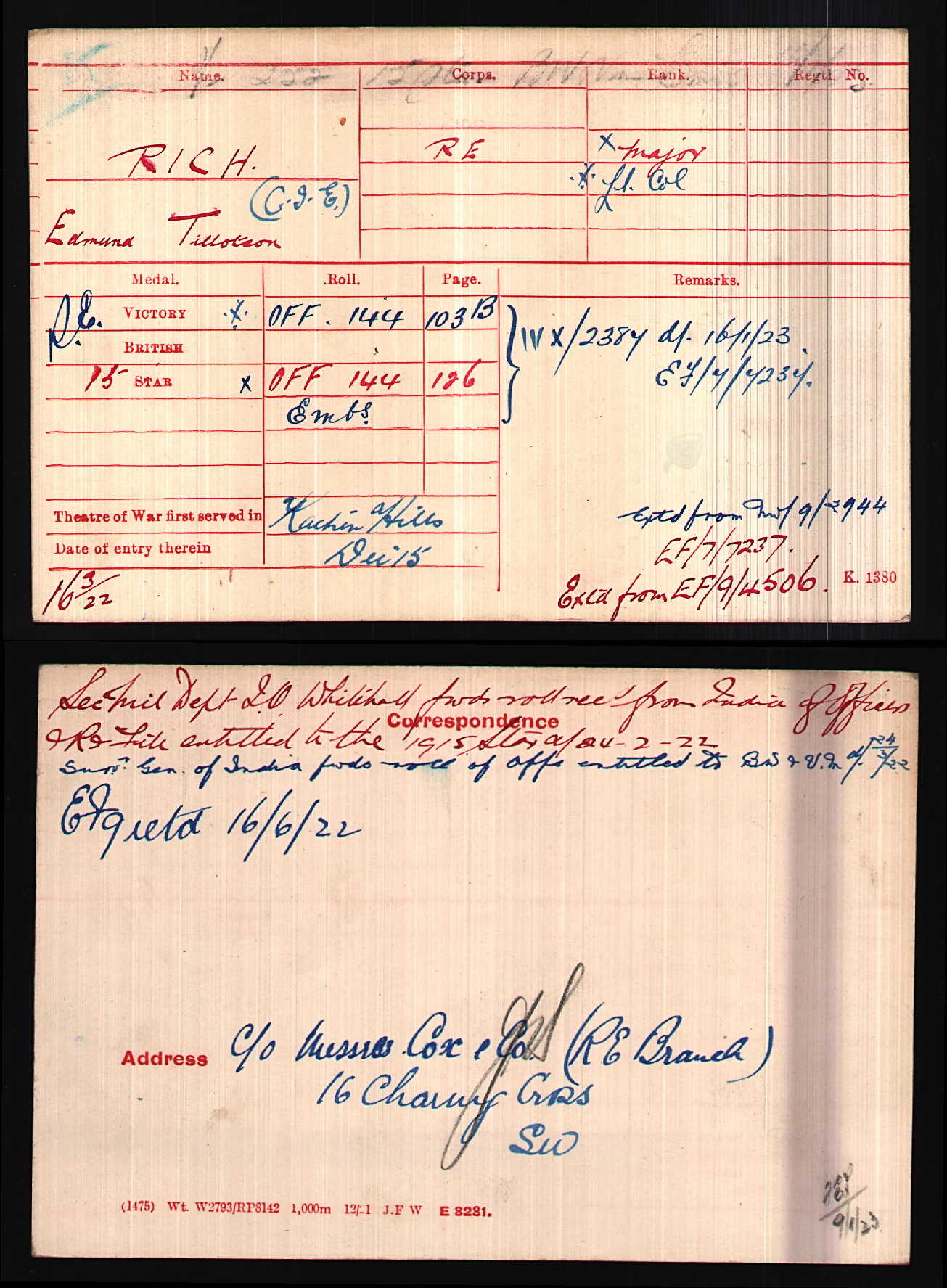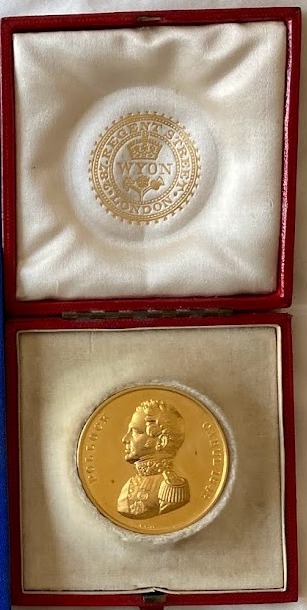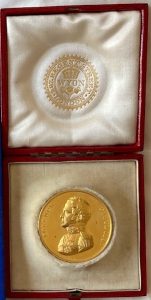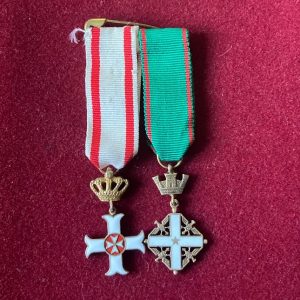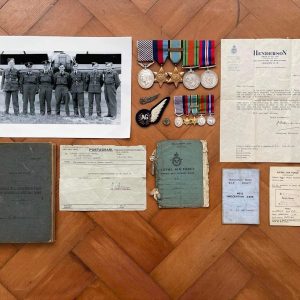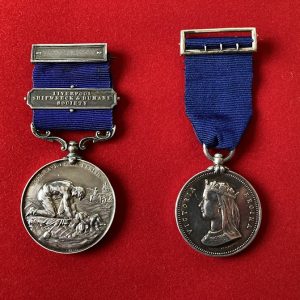Description
The genuinely outstanding medal group of the 1893 Pollock Medal winner, Companion of the Indian Empire C.I.E., twice M.I.D. which comes with some superb original ephemera.
Full Medals – The Most Eminent Order of the Indian Empire, C.I.E., Companion’s neck badge, Indian General Service Medal with North West Frontier 1908 clasp ( Capt. E. T. Rich. R. E. ), 1914/15 Star ( MAJOR E.T. RICH. R.E. ), British War Medal & Victory Medal with M.I.D. emblem ( MAJOR E.T. RICH. ). (5) with the following important items.
- Gold Pollock Medal (66 grams) (2 ounce 24 carat gold) in Wyon, Regent Street box of issue.
- Memoir To illustrate the Origin and Foundation of the Pollock Medal. Frontispiece is dedicated to Rich which confirms the presentation by the Duke of Cambridge. Full recipient list, of which Rich is the last entry at rear.
- Full set of miniatures including CIE (5). Both full medals and miniatures in presentation box of A&NCS Ltd, Medallists, Westminster).
- Original Gazette of India dated March 21 1908, Mention in Despatches.
- Original Mention in Despatches of Lt Gen Sir W. R. Marshall, 7th February 1919, signed Winston Churchill, in original envelope.
- A handwritten scroll dedication (in Urdu) as a farewell message with Rich’s reply address also present. These are highly fragile but hugely important documents in the context of this archive group.
- A small selection of other letters and documents.
- Bronze Pollock Medal – Addiscombe Military Seminary, Pollock Medal, 1st type (1848-55), by B. Wyon, trial striking in bronze,
Awarded the Royal Military Academy Pollock Medal, presented to him by H.R.H. the Duke of Gloucester. Rich was the top student of an intake of 59. The Pollock medal was named for George Pollock, notably for his service in the first Afghan War, when he commanded the force that relieved Sale at Jellalabad and advanced to secure Kabul and victory in the campaign. The medal itself is in its original box, weighs 66 grams of gold and comes with the extremely rare book, in which the frontispiece is dedicated to Rich, titled – Memoir To illustrate the Origin and Foundation of the Pollock Medal. The medal was established by British residents in Calcutta, to reward the most distinguished cadet of the year, initially at Addiscombe, and latterly at Woolwich. The Memoir contains details of Pollock’s career and service. The rear of the book provides a list of recipients of the medal up to and including Rich.
 Army List career record – 2nd Lt 25th July 1893, Lt 25th July 1896, Captain 1st April 1904, Brevet Major 25th July 1908, Major 25th July 1913.
Army List career record – 2nd Lt 25th July 1893, Lt 25th July 1896, Captain 1st April 1904, Brevet Major 25th July 1908, Major 25th July 1913.
Human Sacrifice and Slavery – Colonel Rich’s survey party established the fact that there was a wide system of slavery but definitely confirmed the rumours that Naga tribes on the Burma side were practising human sacrifice – (source – Dense Jungle by Rev. A.T. Houghton). In 1925 he took part in the Sir Harcourt Butler’s Mission to the Hukawng Valley to suppress slavery.
Edmund Tillotson Rich (1874-1937) was a British military engineer and surveyor, Fellow of the Royal Geographical Society. He graduated from the Royal Military Academy with the Pollock Medal and was gazetted in 1893 as 2nd Lt in the Royal Engineers. In 1895 he went out to India and was posted to railway survey work in Burma. In 1905-1909 Rich worked as survey officer on the Indian North-West Frontier, he was sent to Peshawar in charge of No. 12 Party with orders to survey the sensitive area north of Kohat Pass an sent to Peshawar in charge of No. 12 Party with orders to survey the sensitive area north of Kohat Pass and took part in the Bazar Valley and Mohmand Campaigns of 1908 (as a divisional and a chief survey officer respectively). During the latter he was slightly wounded and for his services was promoted brevet-major.
He was first mentioned in the despatches of Major General Sir James Willcocks, Commanding Bazar Valley Field Force dated 5th March 1908, The Gazette of India dated March 21 1908 (original copy of this Gazette included) –“Captain E.T. Rich. A very good officer, most energetic and always to the fore. His maps and reports were of great assistance during operations. He has completed a very useful survey of the Bazar Valley.”
1909-1911 were spent in England (Rich married in 1910).
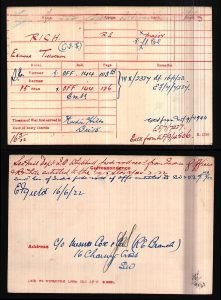
Kachin Hill theatre
In 1911 Rich was appointed the head of the survey office on the Burma frontier post at Myitkyina. Here he was responsible for the surveying of the border with Tibet and Yunnan as well as being caught up in the Kachin Rebellion of 1914-1915. Between 1916-1917 he was responsible for the survey parties in South Persia, based at Bandar Abbas, he was in charge of the survey party looking for the alternative routes between Bandar Abbas and Kerman in South Persia . In 1918 he was in Mesopotamia, before being involved with British intervention in Southern Russia under command of General Dunsterville. Rich carried out important surveys in Baku, Batum and Tiflis. His medal index card confirms the seldom seen theatre of war of Kachin Hills.
 After WWI Rich returned to Burma where he became the head of the Burma Circle of the Survey of India. In 1920-22 while surveying the unadministered territory between Burma and Assam he encountered slavery and human sacrifices still practiced there; in 1925 he took part in the Sir Harcourt Butler’s Mission to the Hukawng Valley to suppress slavery.
After WWI Rich returned to Burma where he became the head of the Burma Circle of the Survey of India. In 1920-22 while surveying the unadministered territory between Burma and Assam he encountered slavery and human sacrifices still practiced there; in 1925 he took part in the Sir Harcourt Butler’s Mission to the Hukawng Valley to suppress slavery.
He married Aileen Owen at Cawnpore, Bengal, 1919. She died at Cawnpore 1919. Freeman of the City of London 1910. Widowed, he later married Rebecca Kathleen Marriott in Worcestershire 1924.
Rich retired with the rank of Colonel and C.I.E. in 1929. “Colonel Rich was a great linguist, and besides his knowledge of Urdu, Pushtu, and Persian, he was able to converse in Yunnanese and several dialects of Burma – Kachin, Maru, and Lisaw […] He was a keen explorer throughout his career and did much to encourage a spirit of adventure in younger officers who served under him” (Obituary, The Geographical Journal 91.1 [1938], p. 96).
Full Medals – The Most Eminent Order of the Indian Empire, C.I.E., Companion’s neck badge in box of issue ( the box itself is in poor condition), Indian General Service Medal with North West Frontier 1908 clasp ( Capt. E. T. Rich. R. E. ), 1914/15 Star ( MAJOR E.T. RICH. R.E. ), British War Medal & Victory Medal with M.I.D. emblem ( MAJOR E.T. RICH. ). The 4 medals are swing mounted as worn. (5)
Selling with –
- Gold Pollock Medal (24 carat gold) (44.5mm diameter – 66 grams) in Wyon, Regent Street box of issue (see item 4) – The intrinsic value of this 2.33 ounce medal is significant.
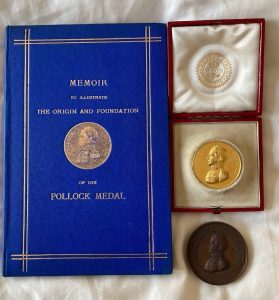
- Bronze Pollock Medal – Addiscombe Military Seminary, Pollock Medal, 1st type (1848-55), by B. Wyon, trial striking in bronze,
- Memoir To illustrate the Origin and Foundation of the Pollock Medal. Frontispiece is dedicated to Rich which confirms the presentation by the Duke of Cambridge. Full recipient list, of which Rich is the last entry at rear.
- Full set of miniatures including CIE (5). Both full medals and miniatures in presentation box of A&N.C.S. Ltd, Medallists, Westminster).
- Original Gazette of India dated March 21 1908, Mention in Despatches.
- Original Mention in Despatches of Lt Gen Sir W. R. Marshall, 7th February 1919, signed Winston Churchill, in original envelope.
- A handwritten scroll dedication (in Urdu) as a farewell message with Rich’s reply address also present. These are highly fragile but hugely important documents in the context of this archive group.
- A small selection of other letters and documents.
- Large monochrome photograph, on card, showing Rich, in uniform, wearing his C.I.E. and this medal group.
Note – POLLOCK MEDAL – Addiscombe Military Seminary, by B. Wyon, obverse: bust of Major-General Sir George Pollock facing left, in uniform, wearing the star of the Knight Grand Cross of the Bath and the Cabul Medal 1842, with a circumscription in four bands, (inner ) ‘Major General Sir George Pollock G.C.B. Bengal Artillery’; (intermediate 1) ‘Treachery avenged – British honor vindicated – Disasters retrieved – British captives delivered’; (intermediate 2) ‘Kyber Pass Forced – Jellalabad relieved – Victories of Mamoo Khail – Jugdulluck – Tezeen – Istalif’; (outer) ‘To commemorate eminent services; Cabul 1842’; reverse: ‘Military Seminary Addiscombe Pollock Prize, Presented by the British inhabitants of Calcutta and awarded by the Court of Directors of the East India Company to the Most Distinguished Cadet of the Season’,
PAYPAL is NOT available for this item. All buyers must contact us to agree shipping prior to order. Email ttandm4h@outlook.com for details or call 07765 595662 to arrange.
Bank Transfer (Account name: ttandm4h, Sort Code 30-94-41, Account number 48469068).
Part Exchange welcome.


















